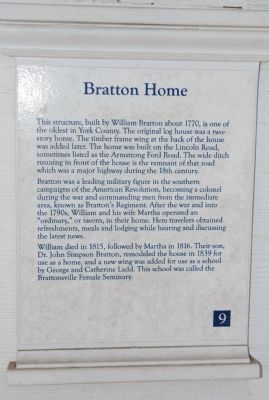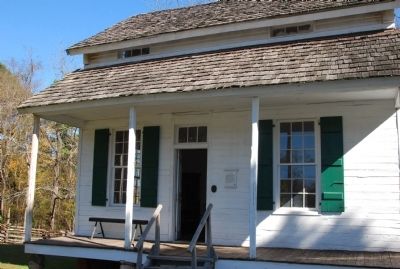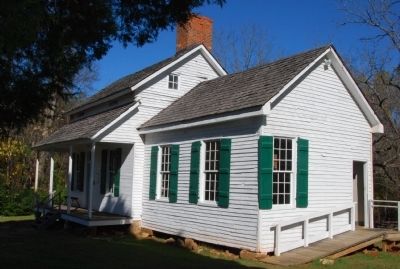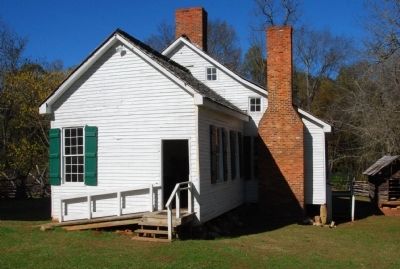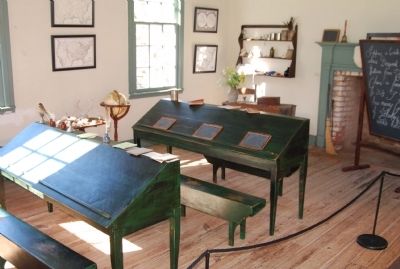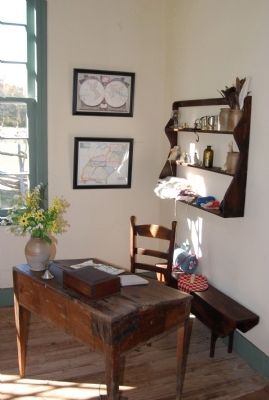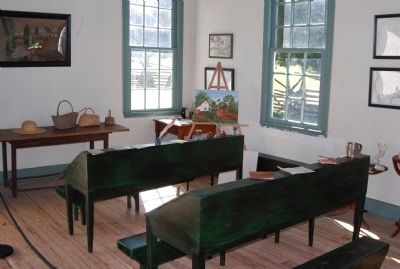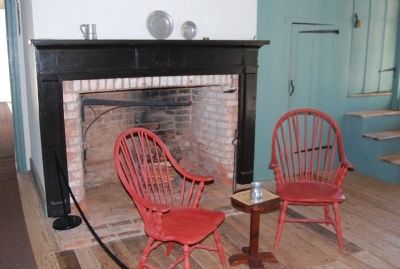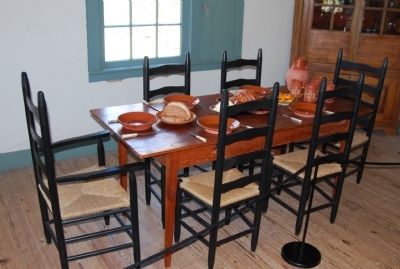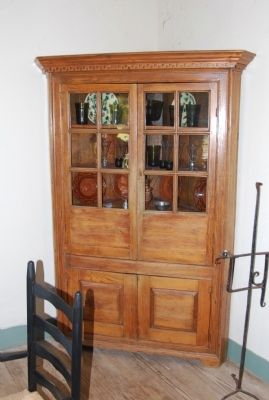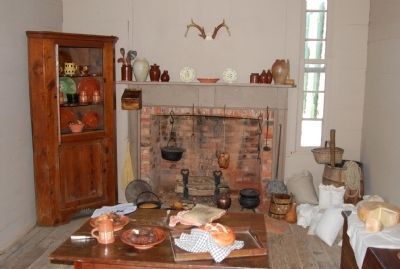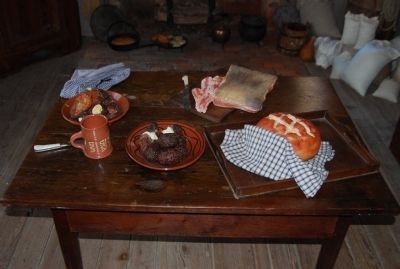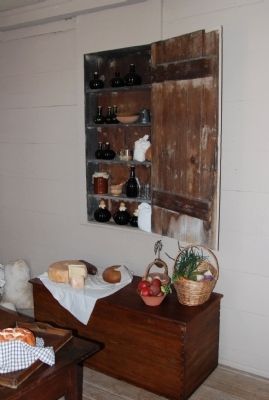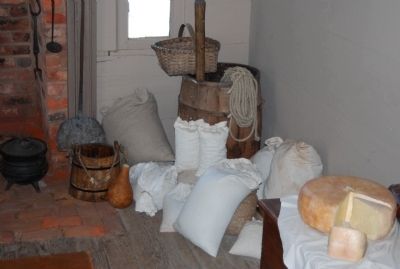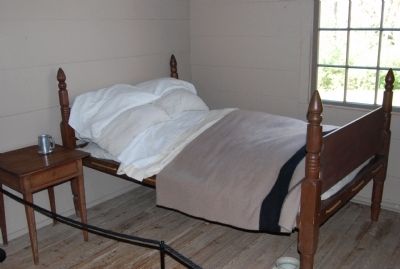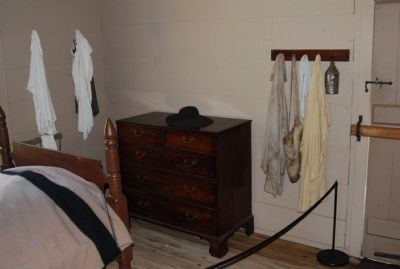Near McConnells in York County, South Carolina — The American South (South Atlantic)
Bratton Home
This structure, built by William Bratton about 1770, is one of the oldest in York County. The original log house was a two-story home. The timber frame wing at the back of the house was added later. The home was built on the Lincoln Road, sometimes listed as the Armstrong Ford Road. The wide ditch running in front of the house is the remnant of that road which was a major highway during the 18th century.
Bratton was a leading military figure in the southern campaigns of the American Revolution, becoming a colonel during the war and commanding men from the immediate area, known as Bratton’s Regiment. After the war and into the 1790s, William and his wife Martha operated an “ordinary,” or tavern, in their home. Here travelers obtained refreshments, meals and lodging while hearing and discussing the latest news.
William died in 1815, followed by Martha in 1816. Their son, Dr. John Simpson Bratton, remodeled the house in 1839 for use as a home, and a new wing was added for use as a school by George and Catherine Ladd. This school was called Brattonsville Female Seminary.
Topics. This historical marker is listed in these topic lists: Notable Buildings • War, US Revolutionary. A significant historical year for this entry is 1770.
Location. 34° 51.981′ N, 81° 10.553′ W. Marker is near McConnells, South Carolina, in York County. Marker can be reached from Brattonsville Road, half a mile north of Percival Road. Touch for map. Marker is at or near this postal address: 1444 Brattonsville Rd, Mc Connells SC 29726, United States of America. Touch for directions.
Other nearby markers. At least 10 other markers are within 3 miles of this marker, measured as the crow flies. William Bratton Plantation/Battle of Huck's Defeat (about 300 feet away, measured in a direct line); Field of Huck's Defeat (about 300 feet away); The Battle of Huck’s Defeat (about 300 feet away); Backwoods Cabin (about 400 feet away); Brick Kitchen (about 500 feet away); The Homestead (about 600 feet away); Brattonsville (about 600 feet away); A House of Untold Stories (about 800 feet away); Huck's Defeat (approx. 0.6 miles away); Bethesda Presbyterian Church (approx. 2.2 miles away). Touch for a list and map of all markers in McConnells.
More about this marker. Marker can't be seen from the roadway and is part of the Brattonsville Historic Site.
Also see . . .
1. Brattonsville Historic District. Brattonsville is a small but important area of York County significant for its architectural record of South Carolina development. (Submitted on January 10, 2010, by Brian Scott of Anderson, South Carolina.)
2. Historic Brattonsville. Historic Brattonsville is a 775-acre American Revolution living history site and is a member of the Culture & Heritage Museums of York County, South Carolina. (Submitted on January 10, 2010, by Brian Scott of Anderson, South Carolina.)
3. The Battle of Williamson's Plantation (Huck's Defeat). The Battle of Huck's Defeat was a significant turning point for the back country during the American Revolution. (Submitted on January 10, 2010, by Brian Scott of Anderson, South Carolina.)
Additional commentary.
1. Brattonsville Historic District
Brattonsville Historic District includes three distinctive homes built by a prominent York County family, the Brattons, between 1776 and 1855. The two oldest buildings, greatly in need of repair, have been leased by the York County Historical Association which hopes to restore them as house museums. The third house is being privately renovated as the country home of a member of the South Carolina General Assembly.
(1) The Revolutionary House, built 1776 by Colonel William Bratton, was originally a one room log house with small porch centered by wooden door. Main room with large seven-foot fireplace (one of three in house) and enclosed stairway leading to room above. Side-wing and back room later added to original structure. Other innovations included clapboard over original logs, interior plaster and window panes.
(2) The Homestead, second house built at Brattonsville (c. 1830) was home of Dr. John S. Bratton. This stately, twelve room, 2 1/2 story ante-bellum mansion adheres to Greek prototypes. Entrance has recessed transom and sidelights flanked on both sides by a pair of shuttered windows. Large central window with transom and sidelights is on second level above main entrance, a pair of shuttered windows on either side. Two identical wings each have pair of shuttered windows and end chimney. Arched breezeway at rear leads to detached dining room. Dining room entrance has semi-elliptical fanlight and sidelights. Interior features Adam mantels, exquisite dadoes, curved staircases.
(3) The Brick House, built 1855, has two-story brick facade with end chimneys, first floor porch and second floor portico supported by white stucco-over-brick columns, triangular pediment above second floor portico centered with half-round window, two-story wooden wing at back. Extremely thick Common Bond brick walls, original shutters assembled with pegs and hung on long hand-made hinges, most of original window glass intact. Brick section of house has one room on either side of central hallway above and below. Circular stairway in wooden wing leads to second floor. Adam mantels; wide-board, short-leaf heart pine floors; antique, rectangular iron locks.
Significance
Brattonsville is a small but important area of York County significant for its architectural record of South Carolina development and for its association with the Revolutionary Confederate and Reconstruction eras of state history.
Since completion of the Revolutionary House in 1776, Brattonsville has witnessed almost two centuries of South Carolina history. Battle of Williamson's Plantation (July 12, 1780), one of first victories of American militia over British Cavalry took place nearby when Colonel William Bratton, builder of the Revolutionary House, attacked several hundred Tories led by Captain Christian Huck. Forty Britishers, including Huck, were killed. On the evening before the battle, Tories came to the Revolutionary House threatening to kill Martha Bratton, Colonel William Bratton's wife, unless she revealed her husband's route. She refused, but her life was spared when another Britisher intervened.
The Homestead, built 1830 by Dr. John S. Bratton, was significant as center of an 8500 acre agricultural complex.
The Brick House, initially used as a private boarding school for girls and later as a Bratton residence, was built in 1855 and remains in excellent condition.
Brattonsville had considerable connection with the Confederate and Reconstruction history through Dr. James Rufus Bratton. He served as a surgeon with the Confederate 5th Infantry in charge of hospitals at Camp Windor, Richmond, Virginia and at Milledgeville, Georgia. In Reconstruction years, Dr. Bratton was an active leader in the York County area and provided the basis for Thomas Dixon's main character in The Clansman.
Architecturally, the small rural area displays three distinct styles: the pioneer simplicity of the Revolutionary House; ante-bellum elegance with adherence to Greek prototypes in the Homestead (its columned double piazzas were later destroyed by tornado); and Georgian, with minor variations, in the Brick House. (Source: National Register nomination form.)
— Submitted January 10, 2010, by Brian Scott of Anderson, South Carolina.
Credits. This page was last revised on April 3, 2023. It was originally submitted on November 14, 2009, by Michael Sean Nix of Spartanburg, South Carolina. This page has been viewed 1,266 times since then and 48 times this year. Photos: 1, 2, 3, 4, 5, 6, 7, 8, 9, 10, 11, 12, 13, 14, 15, 16. submitted on November 14, 2009, by Michael Sean Nix of Spartanburg, South Carolina. • Kevin W. was the editor who published this page.
